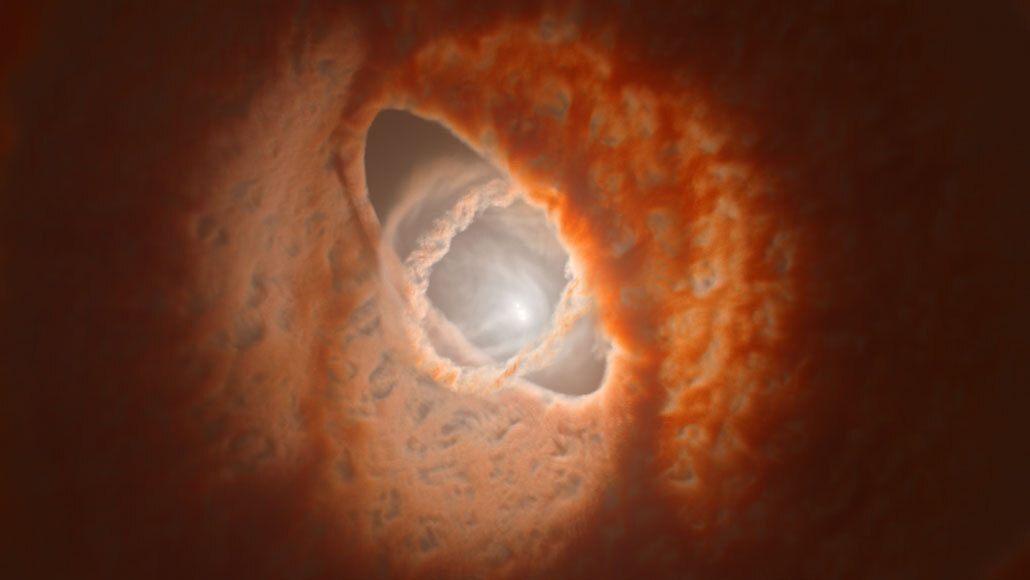
The star system GW Orionis is surrounded by a complicated trio of rings that could form planets, as shown in this artist’s illustration.
L. Calçada/ESO, S. Kraus et al, Univ. of Exeter
- More than 2 years ago
In one of the most complex cosmic dances astronomers have yet spotted, three rings of gas and dust circle a trio of stars.
The star system GW Orionis, located about 1,300 light-years away in the constellation Orion, includes a pair of young stars locked in a close do-si-do with a third star making loops around both. Around all three stars is a broken-apart disk of dust and gas where planets could one day form. Unlike the flat disk that gave rise to the planets in our solar system, GW Orionis’ disk consists of three loops, with a warped middle ring and an inner ring even more twisted at a jaunty angle to the other two.
The bizarre geometry of this system, the first known of its kind, is reported in two recent studies by two groups of astronomers. But how GW Orionis formed is a mystery, with the two teams providing competing ideas for the triple-star-and-ring system’s birth.
In a Sept. 4 study in Science, astronomer Stefan Kraus of the University of Exeter in England and colleagues suggest that gravitational tugs and torques from the triple-star ballet tore apart and deformed the primordial disk. But in a May 20 study in the Astrophysical Journal Letters, Jiaqing Bi of the University of Victoria in Canada and colleagues think that a newborn planet is to blame.
“The question is how do you actually form such systems,” says theoretical physicist Giuseppe Lodato of the University of Milan, who was not on either team. “There could be different mechanisms that could do that.”
Sign up for our newsletter
We summarize the week's scientific breakthroughs every Thursday.
Astronomers have seen tilted disks of gas and dust around binary star systems, but not systems of more than two stars (SN: 7/30/14). Around half of the stars in the galaxy have at least one stellar companion, and their planets often have tilted orbits with respect to their stars, going around more like a jump rope than a Hula-Hoop (SN: 11/1/13). That misalignment could originate with the disk in which the planets were born: If the disk was askew, the planets would be too.
About a decade ago, astronomers first realized that GW Orionis has three stars and a planet-forming disk, and the scientists scrambled to get a closer look. (At the time, it was impossible to tell if that disk was a single loop or not.) Bi’s team and Kraus’ team aimed the Atacama Large Millimeter/submillimeter Array in Chile at the triple-star system.
Both groups spotted the trio of stars: one about 2.5 times and another about 1.4 times the sun’s mass orbiting each other once every 242 days, and another 1.4 solar mass star orbiting the inner pair about every 11 years.
The observations also revealed three distinct rings of dust and gas encircling the stars. The closest ring to the star trio lies about 46 times the distance from Earth to the sun; the middle one about 185 times the Earth-sun distance; and the outermost ring about 340 times that distance. For perspective, Neptune is about 30 times the distance from Earth to the sun.
That innermost ring is strongly misaligned with respect to the other rings and the stars, the teams found. Kraus’ group added observations from the European Southern Observatory’s Very Large Telescope to show the shadow of the inner ring on the inside of the middle loop. That shadow revealed that the middle ring is warped, swooping up on one side and down on the other.

Next, both groups ran computer simulations to figure out how the system formed. This is where their conclusions begin to differ, Bi says. His team suggests that a newly formed, not-yet-discovered planet cleared its orbit of gas and dust, splitting the inner ring off from the rest of the disk (SN: 7/16/19). Once the disk was split, the inner ring was free to swing around the stars, settling into its skewed alignment.
Simulations from Kraus’s team, though, found that the chaotic gravity from the triple stars’ orbital dance alone was enough to break up the disk, a phenomenon called disk tearing. Each star tends to keep the disk aligned with itself, and the tug-of-war warped and sheared the disk, and twisted the inner ring even further. Theoretical studies had suggested disk tearing might happen in multiple star systems, but this is the first time it’s been seen in real life, Kraus contends.
“I think it’s plausible that there could be planets somewhere in the system, but they’re not needed to explain the misalignment,” he says. “We don’t need to invoke undiscovered planets to explain what we see.”
The difference may lie in the assumptions that the groups made about the disk’s properties, in particular its viscosity, says astrophysicist Nienke van der Marel, Bi’s colleague at the University of Victoria. A more viscous disk would tear like how Kraus and colleagues propose, but a less viscous disk needs a planet to break apart, she says. She thinks her team’s work is more realistic based on observations of other star systems. But with current technology, there’s no way to tell what the properties of GW Orionis’ disk are really like.
And neither group could explain what made the disk split into three. “We don’t really know what’s causing the outer ring,” Klaus says.
Lodato, who predicted the disk-tearing effect in 2013, thinks GW Orionis is proof that the phenomenon really exists. Back then, Lodato and colleagues were “very worried” that their simulations showed an effect that was introduced by the computations, not real physics, he says. “Now observations tell us that it does happen in reality.”
Future telescopes may also be able to spot the planet if it exists, van der Marel says.







